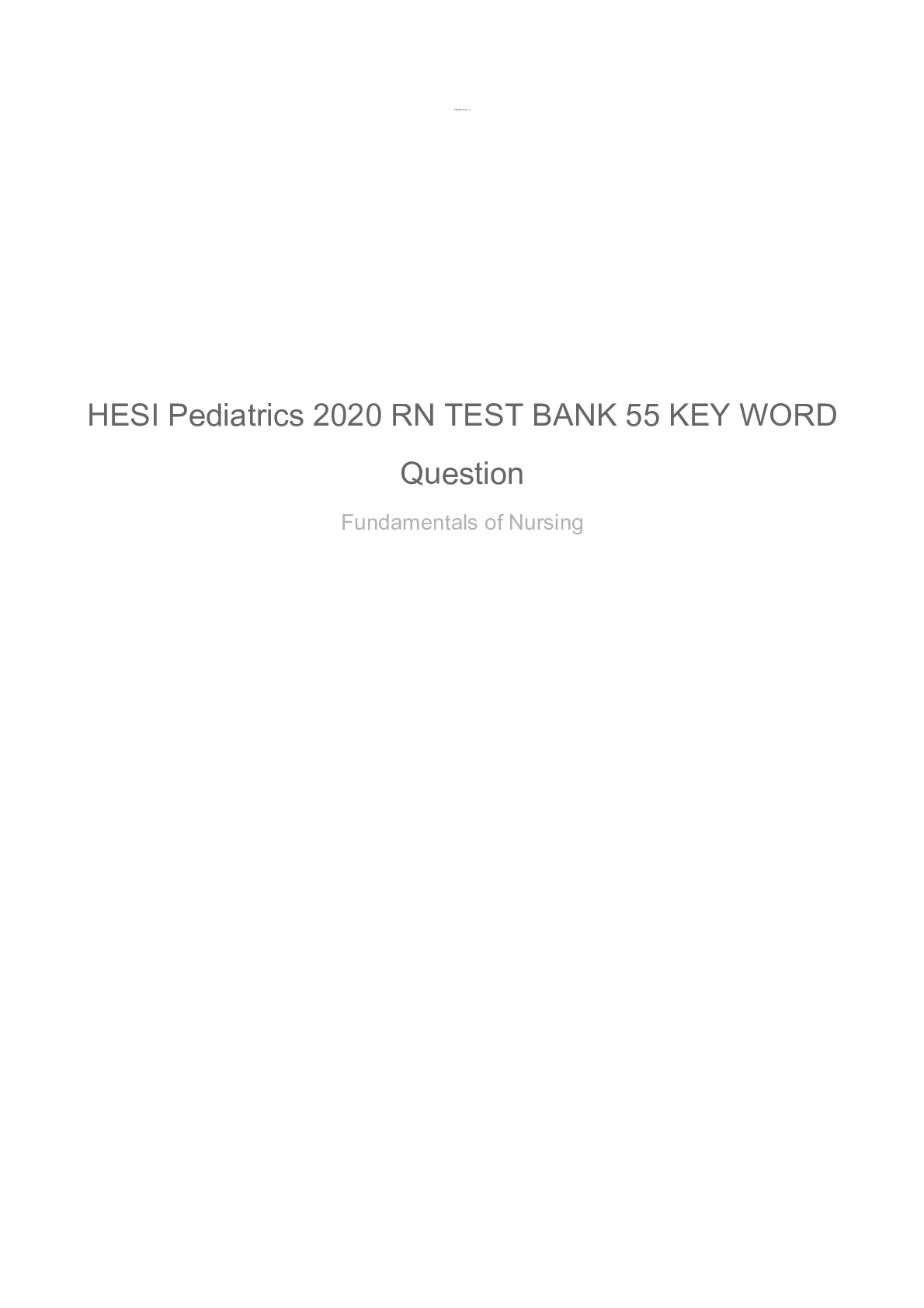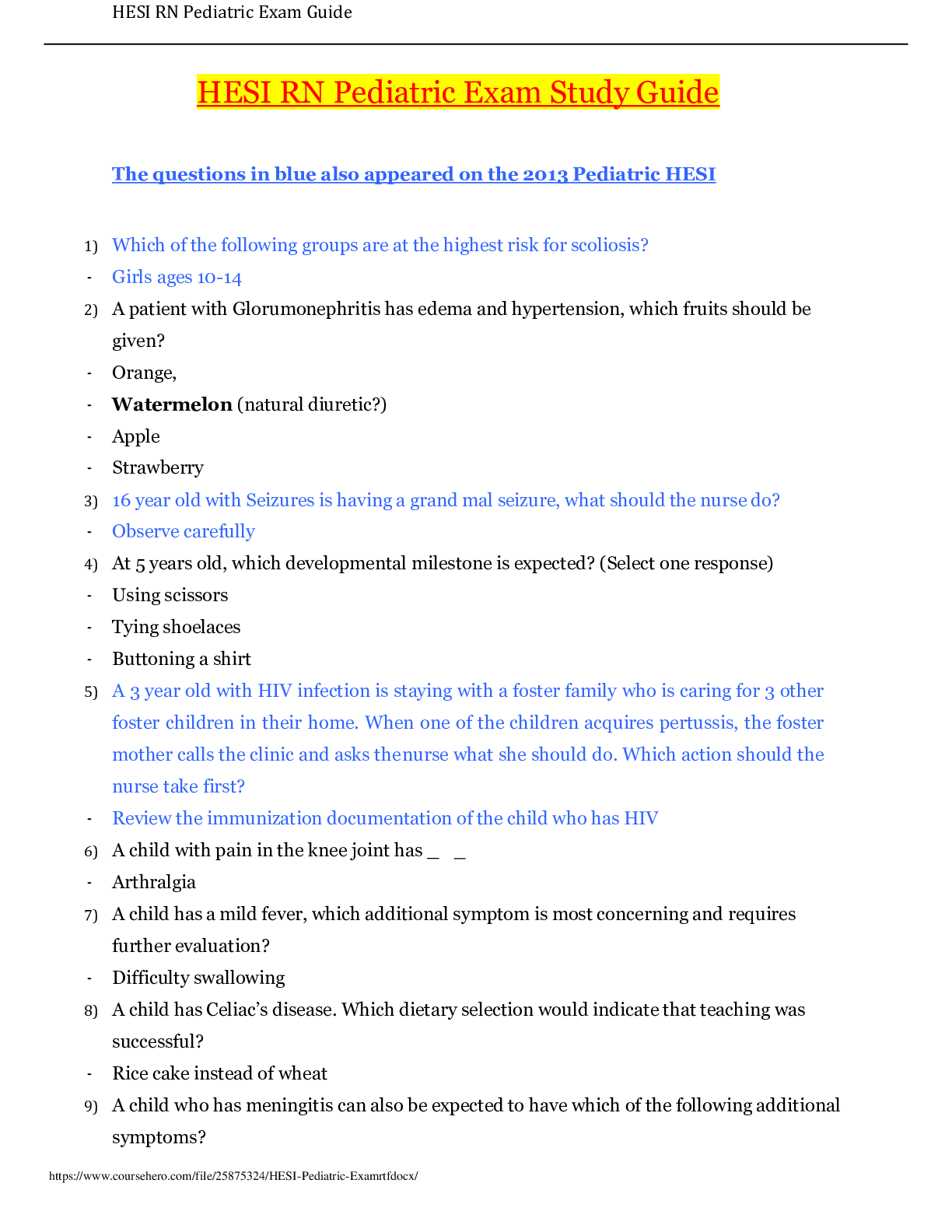Med-Surg Final Exam Study Guide (2020)
Document Content and Description Below
Tema 1: Cancer screenings: Screening tests for some cancers 1 1- Colon Cancer XXXXXXXXXXXXXXX Colonoscopy is the gold standard test, if there are lesions, a biopsy is taken Many times, the... client is asymptomatic but occult blood is discovered in the stool during a rectal exam. Risk factors for colorectal cancer Ageolderthan50years Previous colorectal polyps, history of colorectal cancer, History of ovarian or breast, and stomach cancers Smoking and Dietary Habits (not eating veggies). Assessment Blood in stool (most common) detected by fecal occult blood testing, sigmoidoscopy, and colonoscopy Anorexia,vomiting,andweightloss,secondaryAnemia Abnormal stools Ascendingcolontumor:Diarrhea Descendingcolontumor:Constipationorsomediarrhea,orflat,ribbon-likestoolcausedbyapartial obstruction Rectaltumor:Alternatingconstipationanddiarrhea Stages: Stage I – Tumor invades up to muscle layer Stage II – Tumor invades up to other organs or perforates peritoneum Stage III – Any level of tumor invasion, up to 4 regional lymph nodes Stage IV – Any level of tumor invasion; many lymph nodes affected with distant metastasis General interventions 1. Monitor for signs of complications (bowel perforation with peritonitis, abscess or fistula formation (fever associated with pain), hemorrhage (signs of shock), and complete intestinal obstruction. 2. Monitor for signs of bowel perforation, which include low blood pressure, rapid and weak pulse, distended abdomen, and elevated temperature. 3. Monitor for signs of intestinal obstruction, which include vomiting (maybe fecal contents), pain, constipation, and abdominal distention; provide comfort measures. . 2- Breast Cancer XXXXXXXXXXXXXXXXXXXXX Metastasis occurs through the lymph nodes and the common sites (bones and lungs) (brain and liver). Confirmatory Diagnosis: BREAST BIOPSY by needle aspiration or by surgical removal of the tumor with microscopic examination to detect malignant cells. Screening: Begins at age 50 and every 10 years if colonoscopy is negative If colonoscopy has benign polyps – the next colonoscopy is 3 – 5 years History of colorectal disease: every 5 years Sigmoidoscopy: every 5 years Risk factors Age (+ 65 year increases with ages) Obesity:Lifestyle:highfatdietandLowfiberdiet(possiblerisk) Family history genetic predisposition and Previous cancer of the breast, uterus, or ovaries Early menarche and late menopause or Nulliparity (+30 years) High-dose radiation exposure to chest Assessment: Presenceofa orincreaseinhardeningofthebreast Swelling, orpainintheskin Appearanceofthe Malignant tumor: unilateral mass (lump) in one breast, irregular shape, firm and hard, embedded in the surrounding tissue Benign tumor: single or multiple lumps in one or both breasts. Round, smooth or firm, mobile. . MRI: especially when the mammogram is inconclusive. Determine the actual size of the cancer BreastBiopsy: Breast self-examination and client instructions. 1. Take advantage of the bathroom schedule and with the opposite hand carry out the self-examination with the fingertips in a circular spiral or from top to bottom. The same is done on the opposite breast. Also examined in the armpit area 2. The objective is to 3. Stand with your arms at your sides, raise your arms and check for changes in the shape of your breasts, dimpling of the skin, or changes in the nipple. 4. Then place your hands on your hips and press firmly, squeezing the pectoral muscles to see if there are any asymmetries or changes. 5. Lie down and repeat step 1, 6. Mark on your calendar that you have completed your self-test 7. Write down any changes or unique features you want to discuss with your healthcare provider. BRCA1 and BRCA2: Genetic blood test that can indicate if you have an increased risk of cancer). It can be done in both women and men Recommended for women who have A consent form is required. It cannot be done within 3 months of a blood transfusion. HER2 gene cell: A pathology report from a biopsy may determine if cancer cells contain the HER2 gene. If the result is positive Patients with HER2 may be successfully treated with a targeted therapy for this type of cancer 2 bump or ball indentations (such as orange peel), redness, nipple (retraction) Diagnosis: Triple Approach BSE (Breast Self-Examination), Perform regularly 7 to 10 days after menstruation. Clinical breast exam (CBE): - 1 to 3 years for women 20 and 30 - Annually for women age 40 and older. Mammography: beginning at age 40 and older It is the only definitive way to diagnose breast cancer. verify in time the presence of lumps, hard nodules or thickening of the tissue. Look at your breasts in a mirror. 2 first-degree relatives who were diagnosed with breast cancer before age 50 or women who have a family history of breast and ovarian cancer. , this gene may be responsible for the rapidly cancerous growing cells. Trastuzumab (Herceptin), Nursing Care Postoperative [Show More]
Last updated: 1 year ago
Preview 1 out of 25 pages
Instant download

Buy this document to get the full access instantly
Instant Download Access after purchase
Add to cartInstant download
Reviews( 0 )
Document information
Connected school, study & course
About the document
Uploaded On
Aug 18, 2021
Number of pages
25
Written in
Additional information
This document has been written for:
Uploaded
Aug 18, 2021
Downloads
0
Views
39












 Questions with Answers Provided Graded A.png)
 Questions with Answers Provided Graded A.png)
 Questions with Answers Provided Graded A.png)
 Questions with Answers Provided Graded A.png)
 Questions with Answers Provided Graded A.png)
 Questions with Answers Provided Graded A.png)

